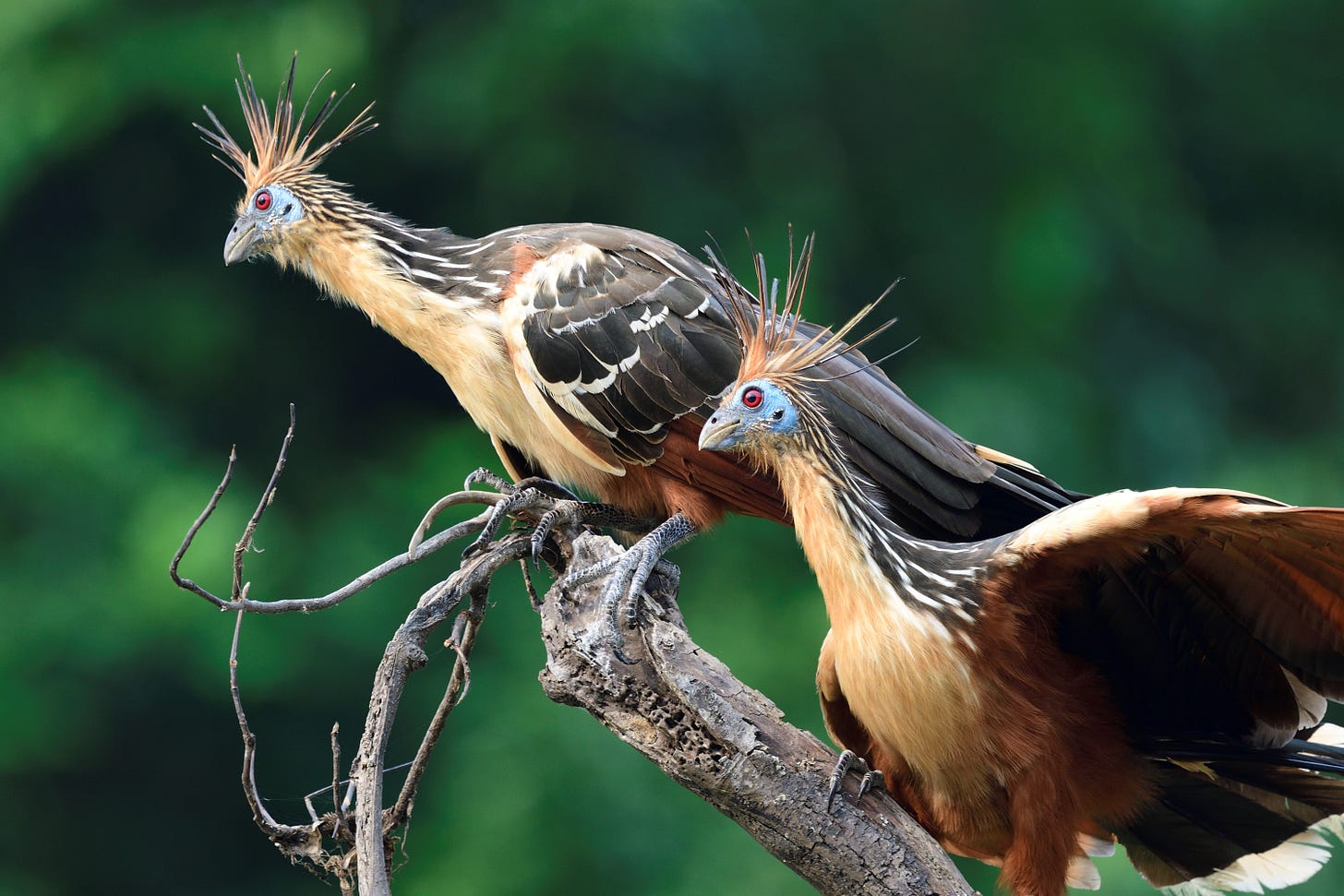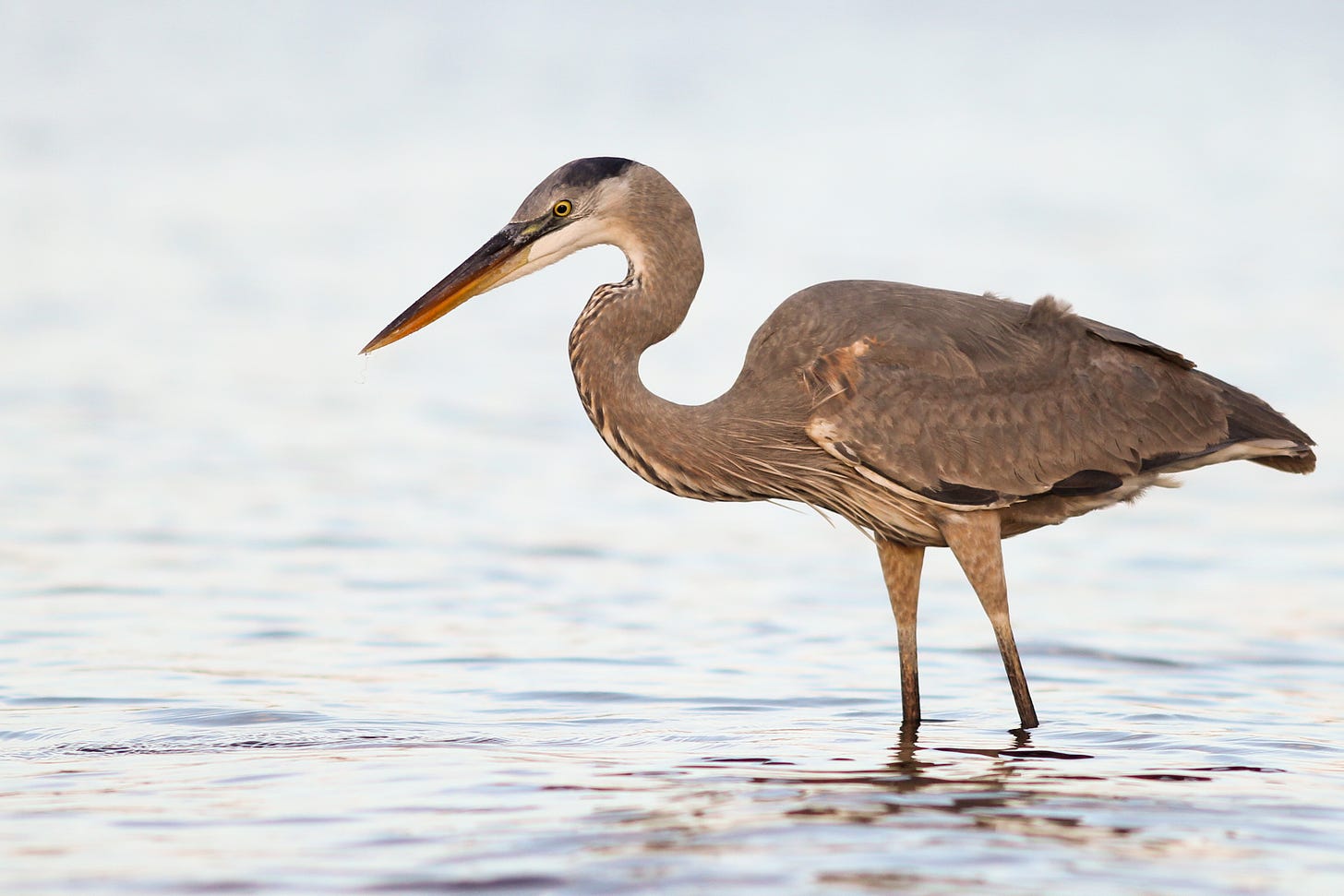While paddleboarding the Willamette river south of Portland, Oregon, in early July, I heard an odd sound. There were osprey hunting for fish, hovering in midair before diving, fast and straight, into the water. After a successful dive, one bird flew off with the fish still struggling in its talons. This was not the source of the sound, though.
On a sandy beach on the far shore from where the Clackamas river joins the Willamette, a turkey vulture was guarding his own fish against a persistent, insistent crow. Crows are large birds, but turkey vultures dwarf them. Still, the crow proved to be too much of a threat, so the turkey vulture flew off with the large fish barely grasped in his own feet, finally getting aloft enough to land on the branch of a dying hemlock, where he slowly resumed his meal. This was also, however, not the source of the sound I was hearing.
Swallows flitted over the water, silent. Six ducklings followed their mother around—an impressive number at this time in the season. Most mothers are down to two or three by July, the others having been lost to predation, or just falling behind. But the ducklings were also making no noise beyond the occasional, soft, marp marp.
And on the shore of Goat island, there were great blue herons. They stood stock still, peering into the water, readying themselves to strike. Sometimes you’ll see a couple of GBH’s, as birders tend to refer to them, but I counted 8, no 10, before being distracted by the noise. Over and beyond the island, it seemed, on the far side of the Willamette, was a train. But there were no train tracks there. No, maybe not a train, but a ratchet of some sort? Perhaps a bunch of machines far far away, interspersed with the shouting and squealing of insistent humans?
It was none of these things.
It was a rookery. A rookery of great blue herons.
A heron rookery is a place of communal nesting, where many pairs of herons come together and build platform nests of sticks, which they line with softer material—moss, leaves—for comfort.
Now, I never saw the rookery. It’s rude to walk in on the homes of others, including those of other species, especially given that we’ve left so little for them to have as their own. I stayed off the island, but did paddle close, listening until I was sure: that was the sound of many great blue herons in trees, communicating with one another.
The sound of the heron rookery reminded me of being in the Amazon rainforest, in a canoe on an oxbow lake. Oxbow lakes form out of the meanders of rivers, when long curves are cut off from the main flow, as the still running river water finds a shorter route to travel. In some oxbow lakes in the Amazon, including the one that I have visited on several occasions, there are islands made entirely of spiny palms, from inside the thickets of which emerge…is that a train? A ratchet of some sort? Perhaps a bunch of machines far away…? In the Amazon it was never a heron rookery, though. It was an aggregation of hoatzin. A herd of hoatzin, to be precise.
What, you may well ask, is a hoatzin?
A hoatzin is a large, florid bird, impossibly ugly, until you get up close, and then realize that the hoatzin’s ugliness is in fact quite possible. Phylogenetic systematists—the scientists who try to figure out the deep historical relationships between species—have been reliably befuddled by who the hoatzin are related to. Cuckoos, perhaps? Turacos? Maybe doves?

Some hoatzin—maybe all of them—breed cooperatively, which is a more elaborate social interaction than the mere communal breeding of great blue herons. In hoatzin, a mated pair has up to six helpers-at-the-nest attending them and their babies. The helpers-at-the-nest of adult hoatzin are hoatzin, too, just not yet reproducing directly themselves. They are often yearlings, the children of the mated pair, who have stayed home and become helpers-at-the-nest for their parents’ next brood. Cooperative breeding also opens the possibility for bonding between siblings, especially if younger siblings ever act as helpers-at-the-nest for their elder siblings.
Perhaps the most distinguished feature of hoatzin is that they are ruminants, like cows. Some species of birds are fruit eaters (e.g. toucans) or nectar drinkers (hummingbirds). Others are nut or seed specialists (finches) or bug eaters (woodpeckers). By comparison, the diet of hoatzins is comprised almost entirely of leaves. Like cows, they ferment their food in their stomach—they are in fact the only birds known to engage in foregut fermentation. Also like cows, the smell of manure tends to accompany them. On top of being fabulously strange looking, hoatzin smell terrible.
Fruit and nectar, seeds and insects—these are all full of energy, and so are valuable as food for a wide variety of organisms. By comparison, leaves are low in caloric value. Folivores—leaf specialists—therefore have to eat a lot of leaves to make a (metabolic) living. A lot of leaves—like a lot of anything—will be heavy, and therefore costly to carry around in the gut. At the same time, flight is metabolically quite expensive. And so it has been observed that folivory is rare in flying animals. Fliers don’t tend to be grazers.
Furthermore, because it takes room to get a good ferment going, the transformation of so much of the hoatzin’s anatomy into fermentation structures has left little room for the attachment of flight muscles. Hoatzin are, as a result, inelegant flyers. They fly in short, gangly bursts between spiny palms and somehow manage not to impale themselves as they land. Adults appear to be inexperienced, when in fact what they are is anatomically and physiologically incapable of holding themselves aloft for very long.
By comparison, a great blue heron standing at river’s edge may look improbable—how will that bird manage to take off?—but take off they do. Their flight seems slow and elegant over the water, before they alight in a tree and commence the yelling, ratcheting vocalizations that tell us humans that a rookery is near.
Great blue herons and hoatzins, both, seem improbable. And yet they exist. Similarities between them include their large body size, communal roosting in trees, and the odd noises that they make. Yet one fishes, while the other forages for leaves. One is largely temperate in range, and sometimes migratory; the other lives in the world’s most vast lowland rainforest.
Two birds, similar but different, observed half a world away from each other, offer up questions. Why do these large birds both roost in trees? Do herons have helpers-at-the-nest? If not, why not? Why do they both make sounds that, to human ears anyway, are so unappealing? The list of questions one could generate by comparing these two organisms is immense. Useful comparisons can be made between almost any two species—between goldfish and angelfish, for instance, or between the saber tooth cats of North America (Smilodon) and marsupial “lions” of Australia (Thylacoleo)—both of which are now extinct.
In each case, there is value in placing two species side by side, looking close in at the anatomy and physiology, observing the behavior, taking the long view by reflecting on their deep history. What ecological problems are each solving with their distinct form and function? How are they similar, and how do they differ? And most importantly, why?
Subscribe for free to receive a new post in your inbox every Tuesday; paying subscribers receive audio recordings of Tuesday posts as well.





This is such beautiful writing! Thank you, Heather, for educating and uplifting us in difficult times.
Beautifully written and gratefully enjoyed